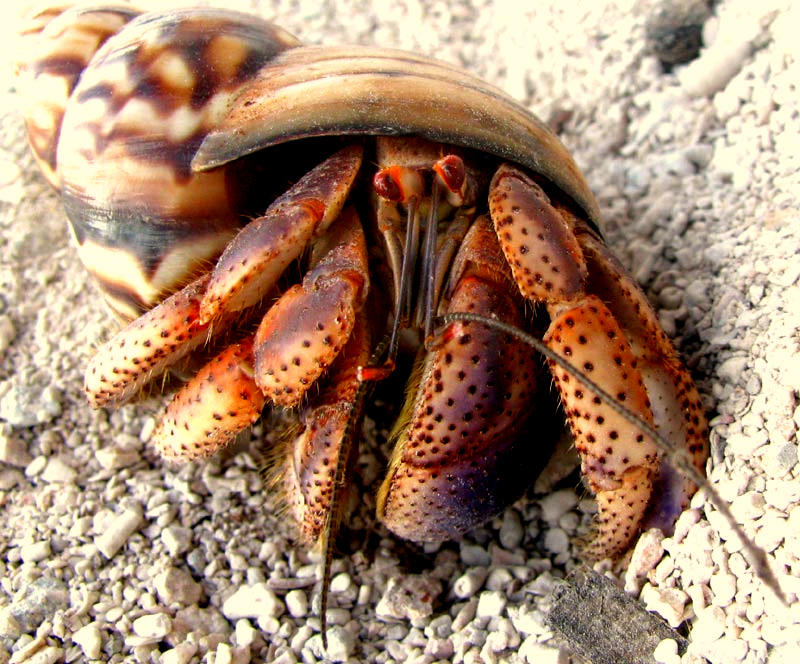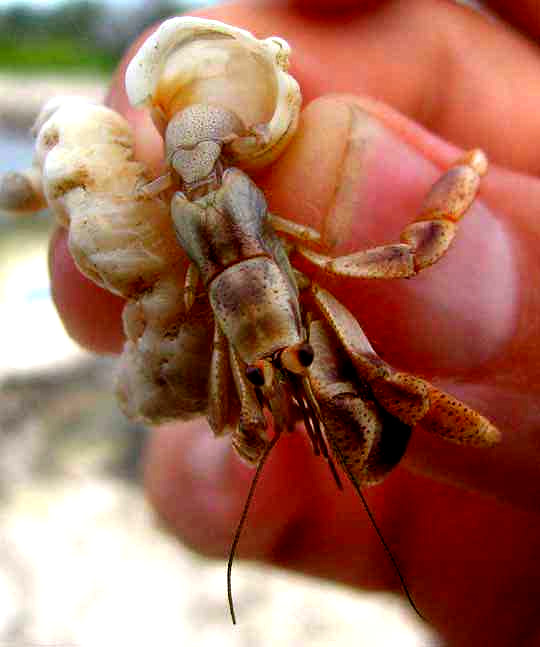Excerpts from Jim Conrad's
Naturalist Newsletter

from the June 6, 2011 Newsletter issued from Mayan Beach Garden Inn 20 kms north of Mahahual; Caribbean coastal beach and mangroves, ~N18.89°, ~W87.64°, Quintana Roo state, MÉXICO
PURPLE PINCHER
Crossing the road from the mangrove swamp to the beach, in the middle of the day, was the critter seen below:

Obviously the shell was produced by a snail, but snails just have one fleshy, undulating "foot." So, what we have here is a joint-legged crustacean pulling a snail shell behind him, and nearly everyone knows that that means we have a hermit crab. Hermit crabs are famous for being special crabs with asymmetrical, spirally curved, relatively soft abdomens, which they protect by moving into empty gastropod shells -- such as snail shells -- which they then drag behind them as in the photo. When threatened, they withdraw into the shell.
About 1100 hermit crab species are recognized, so which one is this? Volunteer identifier Bea in Canada found it hard to be sure, but she thinks that probably the photograph shows the most common species of the Caribbean area, which goes by several English names, including Caribbean Hermit Crab, West Atlantic Crab, Tree Crab and Purple Pincher. It's COENOBITA CLYPEATUS.
Bea was wary of this identification, however, because she couldn't see purple pinchers, a feature listed as one of the species' field marks. I had her doubts in mind the next day when another one wandered across the sandy lawn of a neighbor where I was sitting, and this one let me get right in front of him with my camera and take the purplish-pincher-showing picture seen at the top of this page.
Larger Purple Pinchers are terrestrial, found mostly in humid woods. However, females release their fertilized eggs into the ocean, from which emerge tiny, free-floating "zoea," which float freely in the seawater for some two months regularly metamorphosing until they become "megalopas," which constitute the last of a crab's larval stage. The tiny megalopas find their first shells and begin living both on land and in the water for a month before completing their first molts. After molting the crabs emerge as juveniles and become completely terrestrial. Then as they grow they periodically shed their exoskeletons, each time abandoning their old gastropod shell, and moving into a bigger one.
Purple Pinchers are generalist omnivore scavengers that eat anything from carrion, dead fish, and fallen fruit to rotting wood and sea turtle eggs. The species ranges well inland and can climb high. You might enjoy reading much more about its complex life history here.
from the July 10, 2011 Newsletter issued from Mayan Beach Garden Inn 20 kms north of Mahahual; Caribbean coastal beach and mangroves, ~N18.89°, ~W87.64°, Quintana Roo state, MÉXICO
CRAB IN A WORM SHELL
The other day I came across a crab carrying not the usual snail shell but rather the long, coiled shell of a so-called worm or sea snail, genus Vermicularia. That was so unusual that I picked up the crab and shell for a better look. Shortly the crab surprised me by removing most of his body from the shell as he tried to pull the shell loose from my fingers. This gave me a good view of the crab's long body, which nearly always is hidden inside a shell, as shown below:

This long body cues us to the fact that hermit crabs are not "true crabs," which normally possess rounded, oval or square, and often flattened bodies. In fact, hermit crabs are more closely related to certain kinds of lobsters than to true crabs.
from the August 14, 2011 Newsletter issued from Mayan Beach Garden Inn 20 kms north of Mahahual; Caribbean coastal beach and mangroves, ~N18.89°, ~W87.64°, Quintana Roo state, MÉXICO
HERMIT CRABS TÊTE-À-TÊTE
On the white sand road we came upon what's shown below:

That picture, taken at about 8:30 AM on a sunny day a meter or so onto the road, shows three hermit crabs, each wearing a borrowed mollusk shell. At the right is an immature crab with a small, white shell, while at the left two larger crabs, each wearing a different kind of snail shell, are doing something.
My first thought was that the two adults were mating and that possibly the younger one was attracted there by sex hormones the adults were emitting. However, when dealing with invertebrate sex it's unwise to make assumptions. For instance, how about this question: Do crabs even have penises?
My friend Martin wanted a closer look so he picked them up... and to my astonishment they stayed connected and made no signs of coming undone, as shown below:

If you study that picture you can see that the bottom crab appears to be cowering passively in the shell while the top one is holding the bottom shell in its pincers. There's no sign of a penis, though.
On the Internet I read that "When hermit crabs mate, the male hermit crab positions the female hermit crab in front of him and passes spermatophore packets into her gonopores, where the female hermit crab's eggs are fertilized."
Spermatophore packets are compact little masses of sperm. Among hermit crabs, sex involves the two sexes aligning themselves so that their gonopores, or sexual openings, are opposite one another, enabling the spermatophores to pass from male to female. Male hermit crabs do not have penises.
My friend Martin, a Maya villager who pays attention to things, suggested that the crabs instead of mating might be fighting. In fact I read that among hermit crabs "Competition for new shells is keen and hermit crabs will often steal shells from one another. They will engage in fierce battles, fought to the death, for the possession of an appropriate shell. The loser of the engagement not only loses its life but will be eaten by the victor. It is because of this tendency towards fighting one another that the hermit crab is alternately named 'soldier crab'."
So, who knows what's going on in our pictures? Maybe someday a graduate student working on hermit crab behavior will be thrilled to see them.